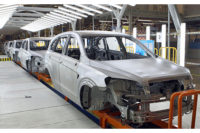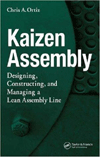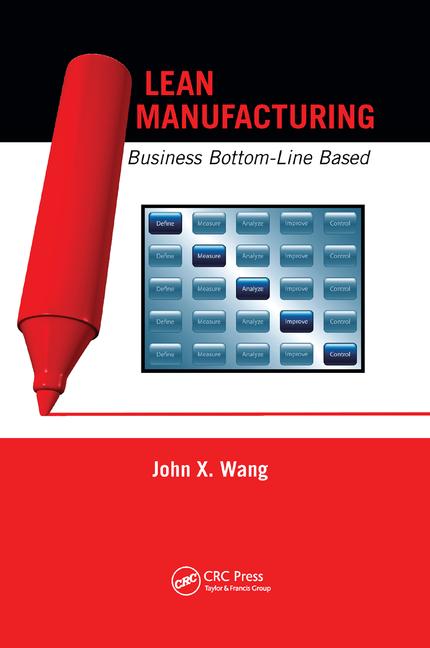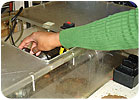
When most people think of workplace injuries, heavy machinery or falling objects likely come to mind. For assemblers, however, work-related repetitive motions are a common source of serious disorders, such as tendonitis or bursitis. In 2009 alone, there were 30,790 repetitive motion injuries in the United States.
Repetitive motion disorders (RMDs) are a family of musculoskeletal conditions that result from repeated motions performed in the course of normal work. If assemblers repeat the same motions frequently and for prolonged periods of time, fatigue and muscle-tendon strain can accumulate, resulting in RMDs. The effects of repetitive motions increase when unnatural or awkward postures and forceful exertions are involved.
The most common RMDs include carpal tunnel syndrome, tendonitis, trigger finger, and aggravation of pre-existing conditions, such as arthritis. These disorders are characterized by pain, tingling, numbness, swelling or redness of the affected area, and the loss of flexibility and strength. For some individuals, there may be no visible sign of injury, although they may find it hard to perform easy tasks. Over time, RMDs can cause temporary or permanent damage to the muscles, nerves, tendons and ligaments, as well as compression of nerves or tissue.
RMDs and other musculoskeletal disorders are among the most prevalent lost-time injuries and illnesses in almost every industry. They’re also the most costly. Employees affected by RMDs might face short- and long-term health issues. If surgery is required, they may even face a disability. Employers must then deal with reduced worker productivity, days away from work, worker compensation claims and increased insurance premiums.
Manufacturing managers can protect their employees’ health and ensure their safety and comfort by designing an ergonomic workplace. If a workplace is correctly designed and tools are safe and easy to use, assemblers need not make unnatural or awkward motions, twist their arms or wrists, overextend themselves or put pressure on their backs-all possible precursors for an RMD.
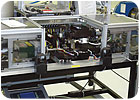
This test stand has guarding that protects the operator against a crushing injury. The doors are closed when the machine is in operation, and they are opened when the machine is idle. Optical finger switches initiate the start cycle. The test stand also has an electrical switch to lower and raise its height.
Embracing Ergonomics
The scope of ergonomics is broad, but the term generally refers to the science of fitting workplace conditions and job demands to the capabilities of the workers. Ergonomic design is necessary to ensure high productivity, avoid illness and injury, and boost satisfaction and morale among the workforce.In addition to a healthy and satisfied workforce, ergonomic workcells offer significant value to manufacturers in terms of decreased turnover, absenteeism and worker compensation premiums. Managers can be reactive or proactive when applying ergonomics. In reactive ergonomics, managers identify current problems and take actions to resolve them. In proactive ergonomics, managers seek areas that can be improved and fix the issues before they become large problems.
We proactively implemented ergonomic design changes at Parker Fluid Control’s plant in New Britain, CT. Many employees who assemble various valves have been with the company for years, and management wanted to ensure that their workcells were comfortable and ergonomically designed.
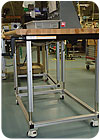
The height of this workbench can be adjusted to make employees of all heights comfortable. This workbench is equipped with a manual lifting system.
Signs of Trouble
How can managers identify workplace design problems? Some signs are obvious, such as when a worker is diagnosed with an RMD. Others are more subtle. Fortunately, a variety of easy-to-use tools are available to assess assembly cell design.One of the simplest is employee feedback. It’s critical that employees feel free to report that certain jobs cause undue physical fatigue, stress or discomfort. Following up on these reports is essential to identify workplace design issues. At Parker, management solicited feedback from assemblers, and we took the time to perform the tasks ourselves to better evaluate assembly processes.
Another good tool is the Rapid Upper Limb Assessment (RULA) worksheet, a postural targeting method for estimating the risks of work-related upper limb disorders. A RULA analysis gives a quick and systematic assessment of the postural risks to an assembler. The analysis can be conducted before and after an intervention to demonstrate that the intervention has lowered the risk of injury.
Managers can download a copy of the sheet at the Cornell University ergonomics web site:http://ergo.human.cornell.edu/ahRULA.html.
A good way to look for risk factors for RMDs and other musculoskeletal disorders is to videotape assemblers as they work. We used such videos to carefully view workers’ movements and focus on their different activities and motions.
Another handy tool to evaluate assembly workplaces is a questionnaire in which assemblers note which activities and motions cause them to feel pinches or pain. In addition to questions about the type, onset and duration of symptoms, questionnaires might include a body map, where respondents can locate and rate their level of discomfort.
Managers can also gain insight into possible musculoskeletal injuries by inspecting the logs of injuries and illnesses required by OSHA, plant medical records, worker compensation claims, absentee records and job transfer applications. If complaints span multiple jobs and departments, a full-scale, companywide ergonomics program may be necessary. If problems are confined to isolated tasks and relatively few workers, it might suggest that only certain work areas need to be redesigned.
While each of these methods offer insight into the quality of the workplace design, an approach combining several or all of these methods will provide the fullest picture.
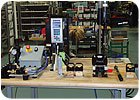
This electric fastening tool operates smoothly and softly, reducing strain on the operator’s arms and hands.
What to Look For
Regardless of the method used to identify workplace RMD risk factors, managers should be on the lookout for several common signs that may indicate a problem. These include:• awkward postures.
• forceful exertions.
• duration (the amount of time a person is continually exposed to a risk factor).
• wrist deviations.
• contact stress (repeated or continuous contact with hard or sharp objects, such as unpadded, narrow tool handles and nonrounded desk edges, may create pressure over one area of the body that can inhibit nerve function and blood flow).
• hand-arm or whole body vibration.
Correct postures and workplace designs will vary depending on the type of work performed (precision, light or heavy) and position (seated or standing), but managers should keep in mind the following guidelines.
When assemblers need to sit to perform tasks, the optimal work surface height varies with the type of work performed:
• precision work: 31 to 37 inches.
• reading and writing: 28 to 31 inches.
• typing and light assembly: 21 to 28 inches.
The height of both the chair seat and the backrest should be adjustable. For a seated person, the boundary for vertically reaching to grasp objects is 32 inches, with an occasional extended reach of 38 to 40 inches.
When assemblers must stand to perform tasks, workbench heights should be as follows:
• precision work: above elbow height.
• light work: just below elbow height.
• heavy work: 4 to 6 inches below elbow height.
Individuals with good posture should have their elbows at a 90-degree angle and their wrists in a neutral position. The head should be straight, not too far forward, and operators should neither lean forward at the waist nor lift their arms above shoulder height.
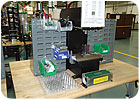
This workstation features a rack with bins set up so all the parts are within the operator’s reach.
Ergonomic Design Components
To improve ergonomics at Parker, we implemented the following components:• Height-adjustable workbenches. To make employees of all heights comfortable at their workstations, we recommended installing height-adjustable workbenches. The redesigned cells now have separate benches for each operation sequence, and each bench is equipped with a lift kit to adjust its height. Locking casters prevent the benches from moving during assembly. If the height of the bench is too high or too low, employees might develop shoulder, back or hand issues.
• Workstation layout. At the redesigned workstations, operators no longer need to lift their arms above shoulder height (about 20 inches from the tabletop) to reach frequently used components. Storage racks were moved forward so operators do not have to bend at the waist to reach parts. Anything that operators have to use or set up frequently should not be higher than shoulder height or farther away than arm’s length.
• Power tool position. Power tools should be positioned within comfortable reach of each operator-no more than 10 inches away and no higher than 12 inches above the item being assembled.
• Potential pressure points. Any obstacles that impede an operator’s ability to move or place an item in position should be eliminated.
• Pinch points. Areas where an operator’s fingers, hands or other body parts can be pinched or crushed must be eliminated or redesigned. Some pinch points are necessary for the function of the equipment, but operators can be protected with light-curtains, anti-tie down switches or guarding.
• Electric tools. We are equipping workcells with electric tools. Compared with pneumatic tools, which tend to jerk at the start and finish, electric tools operate smoothly and softly.
• Mounting arms. Just as tools have improved over time, progressing from manual to pneumatic to electric, new models of mounting arms are much easier and more comfortable to use than previous versions. Old models were bulky, heavy and, at times, difficult to balance. They also required air to maintain support. Newer models are easy to set up, do not require air, feature handles that fit easily into an operator’s hand, and are easy to adjust using spring balancers. The best arm to use depends upon the available space, torque and mounting surface.
• Anti-fatigue mats. The redesigned cells also feature anti-fatigue mats. Many plants have concrete floors, so the mats provide cushioning to relieve the pressure on lower-body joints.
• Room to move. Prolonged standing can produce circulatory problems in the legs and feet, especially standing on hard surfaces. Based on our personal experience of working in the assembly cells and the video analysis of operators at work, we recommend that workplaces allow enough room for movement, such as taking steps from side to side. Operators could sit to relieve pressure on the legs and feet, but they should alternate between sitting and standing whenever possible.
After we began implementing these ergonomic design elements, we received positive feedback from the employees. Most workers noted that they were now more comfortable and requested ergonomic design improvements in other areas of the facility.
When manufacturers implement ergonomic design changes, they should expect to make upfront investments, the amounts of which will depend on the size of the plant and the scope of changes. As an example, a company can invest approximately $700 per set for a manual lift system or $1,000 for an automatic lift system (a set includes four legs and supports roughly 1,000 pounds). A typical cost for an electric fastening system is $14,000, including a DC controller, tool, mounting arm and cables. However, the initial costs of ergonomic design changes will result in better employee health, reduced compensation claims, higher productivity, lower insurance premiums, and, most likely, a better quality product, justifying these investments well into the future.
ASSEMBLY ONLINE
For more information on ergonomics, visit www.assemblymag.com to read these articles:•The Ergo Corner: But Is It Ergonomic?
•Ergonomics: Issues and Trends.
•Ergo Numbers.

